Dec 27, 2022
Words to describe taste
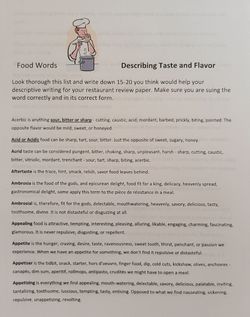
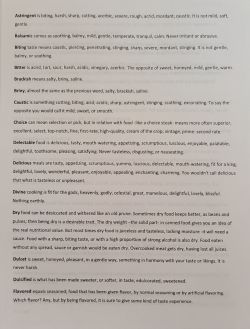
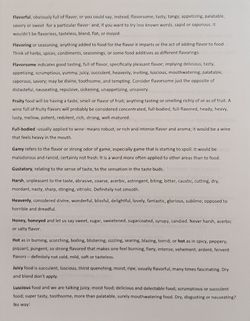
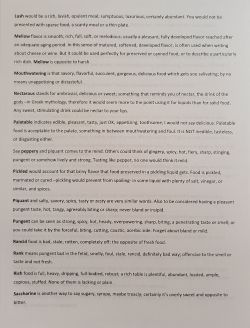
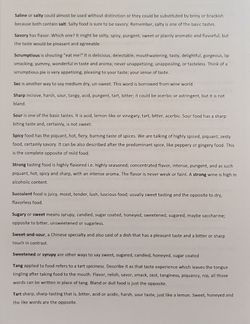
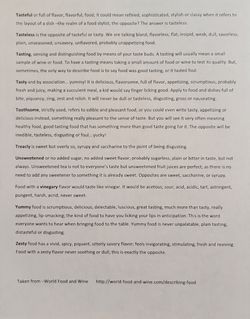
Here are some words that are commonly used to describe food:
Acidic: A food with a sharp taste. Often used to refer to tart or sour foods as well.
Bitter: A tart, sharp, and sometimes harsh flavor.
Bittersweet: A less harsh taste than bitterness. Couples tartness with sweetness.
Briny: Another word for salty.
Citrusy: A bright flavor like that of lemons, limes, oranges, and other citrus fruits.
Cooling: A taste that mimics the feeling of cold temperature. Often used to describe mint.
Earthy: Reminiscent of fresh soil. Often used to describe red wines, root vegetables, and mushrooms.
Fiery: A taste that feels as though it gives off heat. Another word for spicy.
Fresh: A light and crisp taste. Often used to describe produce or herbs.
Fruity: Any taste reminiscent of sweet fruit flavors.
Full-bodied: Rich flavor that can feel heavy in the mouth. Often used to describe wines.
Herbal: A bright, fresh, or sometimes earthy taste created by the incorporation of herbs.
Honeyed: A sweet or candied taste that may be reminiscent of honey.
Nutty: Any taste similar to the flavors of nuts. Often used to describe cheeses.
Rich: A full, heavy flavor. Often used to describe foods containing cream.
Robust: A rich taste with some earthiness. Often used to describe wines or aged liquors.
Sharp: A harsh, bitter, or tart taste. Often used to describe acidic foods.
Smoky: A smoky taste is reminiscent of the smell of smoke.
Sour: A biting, tangy, tart flavor.
Spicy: A burning taste from hot spices.
Sweet: A sugary flavor.
Tangy: A tart, biting taste that feels tingly in the mouth.
Tart: A sharp, bitter, or sour flavor. Often used to describe acidic foods.
Yeasty: An earthy taste reminiscent of yeast. Often used to describe beer and breads.
Woody: An earthy, sometimes nutty taste. Often used to describe coffees or cheeses.
Zesty: A fresh, vivid, or invigorating flavor.
Astringency – Dry, chalky sensation in the mouth
Acidic – Sharp, tart, sour
Acrid – Pungent, sharp, biting, bitter
Alkaline – Dry, somewhat bitter
Ashy – Dry, burnt, smoky, bitter
Barnyard – Dusty, musty, earthy
Burnt – Scorched, bitter
Buttery – Fatty, creamy, rich
Candy-like – Sweet, cooked sugar, cotton-candy
Cardboard – Papery, stale, oxidized
Caustic – Biting, acidic, astringent, stinging
Citrus – Ripe citrus fruit like lemon, lime, grapefruit, orange
Chalky – Dusty, powdery, gritty
Chemical – Medicinal, metal, sulphur
Clean – Without off-flavors or undesirable traits
Cooked – Sulfurous, caramelized, burnt
Delicate – Pleasant, mild, mellow
Earthy – Musty, green
Green – Vegetative, grassy, leguminous
Jammy – Preserved fruit, ripe, pungent, sweet
Lactic – Fresh, heated, acidified or transformed (burnt, rotten) milk
Lipid – Fatty, rich
Malt-like – Sweet, nutty
Medicinal – Chemical, plastic
Musty – Stale, moldy, mildew, damp
Piquant – Pleasantly pungent, tart, zesty, zingy
Pungent – Sharp, intense, penetrating
Phenolic – Plastic, chemical, medicinal
Rancid – Rotten, spoiled, stale, bad
Resinous – Woody, pine, cedar, oak
Smoky – Wood smoke, burnt, char
Sulfur – Rotten eggs, burning, match-like
Tangy – Tart, zesty, mouthwatering
Tart – Sour, sharp, bitter, acidic
Vegetal – Green, beany, raw, grassy
Yeasty – Bready, doughy
Here are some words that are commonly used to describe texture:
Airy: A light, pillowy texture often created by the incorporation of air.
Buttery: A smooth and creamy texture similar to that of butter.
Chewy: The texture of a food that needs to be chewed thoroughly before swallowing. Can be light and bouncy or heavy and sticky.
Creamy: A smooth and rich texture that usually comes from the incorporation of dairy.
Crispy: A light texture with a slight crunch.
Crumbly: The texture of a food with a loose structure that falls apart into small pieces or crumbs.
Crunchy: A firm, crisp texture often identified by the sharp, audible noise that the food makes when being eaten.
Crusty: The texture of a food with a hard outer layer and soft interior.
Delicate: A light, fine texture that may come apart easily.
Doughy: A soft and heavy texture that is often coupled with pale coloring.
Fizzy: A texture brought on by the presence of many small bubbles, usually referring to carbonated liquids.
Flaky: A light texture characterized by layers that come apart during eating.
Fluffy: A light and airy texture.
Gooey: A viscous, sometimes sticky texture arising from the presence of moisture in a dense solid food.
Hearty: A firm, robust texture.
Juicy: A succulent, tender texture characterized by the presence of liquid in a solid food.
Silky: A fine, smooth texture characterized by a sleek feel in the mouth.
Sticky: A texture characterized by gluiness in the mouth.
Smooth: A consistent texture free of grit, lumps, or indentations.
Succulent: A tender, juicy texture.
Tender: A soft texture that is easy to break down.
Velvety: A smooth and rich texture.
By undefined
20 notes ・ 154 views
English
Upper Intermediate